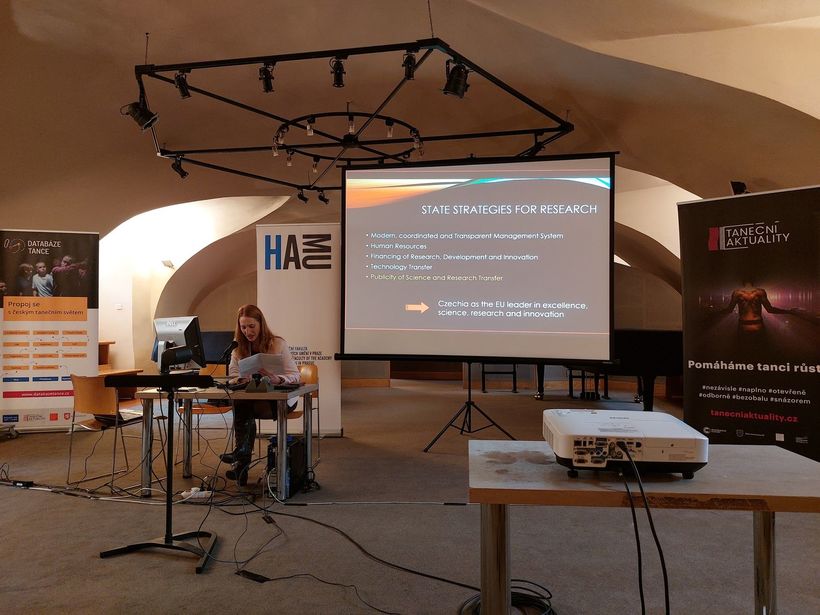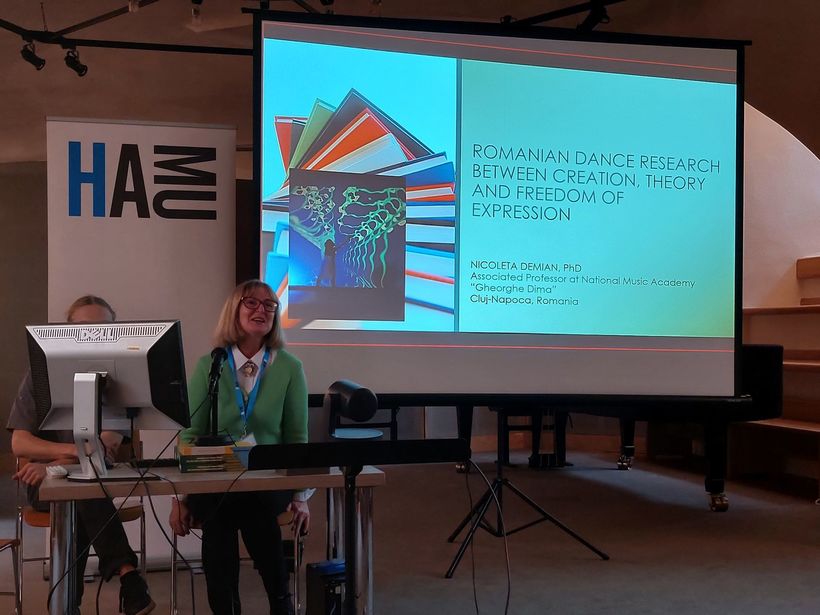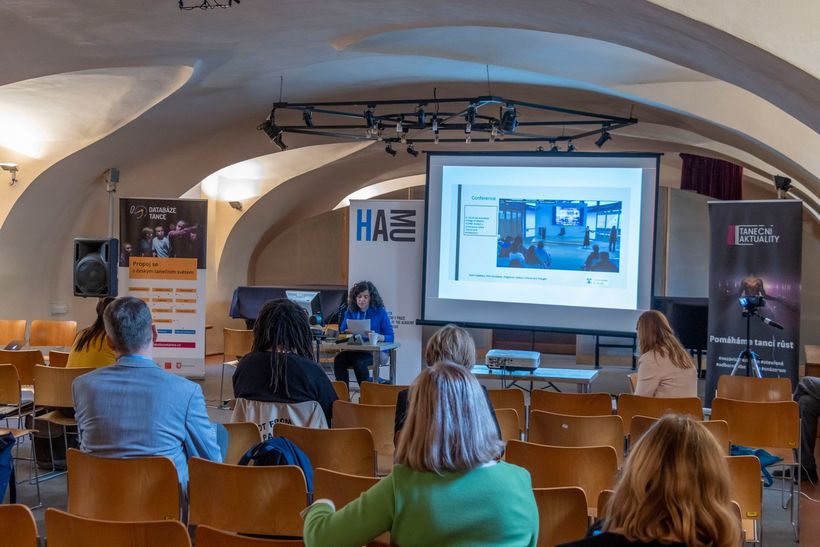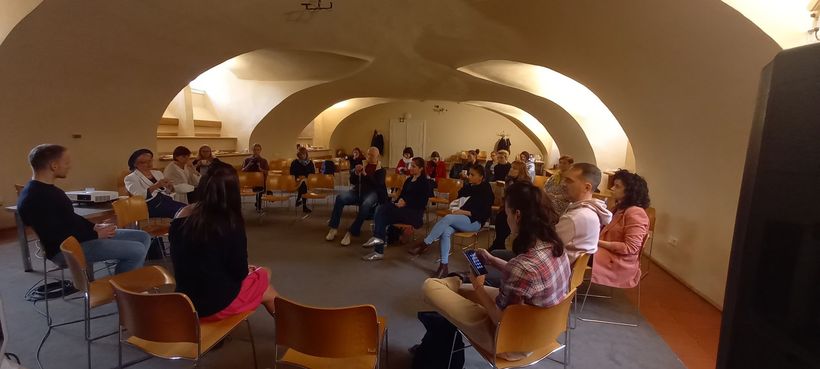The Joys And Sorrows Of Dance Research
The international conference on dance research, organized by the Institute of Choreology, took place in the HAMU Gallery on Friday 7 October 2022. The conference was dedicated to Professor Božena Brodská, who would have celebrated her 100th birthday in July this year. Czech and international authors presented their papers both in the hall and online via live stream. The topics of the conference were the institutionalization of research in dance and its social and cultural context.
The program was divided into six blocks with 17 figures from eight European states: the Czech Republic, Slovakia, Romania, Spain, Austria, Serbia, Germany, and Great Britain.
The conference started with a paper by Lucie Hayashi, the current head of the Dance Department at the Academy of Performing Arts (HAMU), which discussed the popularization of dance research. She focused on how dance research is integrated into the structures of Czech art and cultural organizations, what problems it encounters, how it is supported, and what are opportunities for popularization and visibility right now. Daniela Machová, the director of Taneční aktuality, followed the topic in the last block as she touched upon issues of Czech dance research and dance researchers in the Czech Republic. The output of her qualitative research showed that due to the financial challenges, Czech dance researchers are forced to engage in their research in their free time, which has a fundamental impact on the field and new emerging researchers.
The dismal financial aspect of dance research was also discussed by Blanka Marková from Vize tance. She analyzed cultural and political strategies towards dance in the Czech Republic, as well as the general response and opinions about the need for dance research in general. She emphasized the need for the presentation of the positive impacts research of dance can have on society, thus improving the relevance of the field in the context of other humanities and their work.
 Dorota Gremlicová, a professor at HAMU and the head of the Institute of Choreology, had a paper on choreology as an independent field of research. She pointed out its uniqueness, and the need for its distinctive direction that is based on dance as such, which then leads to increasing the relevance of outputs and research within and outside the community.
Dorota Gremlicová, a professor at HAMU and the head of the Institute of Choreology, had a paper on choreology as an independent field of research. She pointed out its uniqueness, and the need for its distinctive direction that is based on dance as such, which then leads to increasing the relevance of outputs and research within and outside the community.
Two representatives of the VŠMÚ, Kristián Kohút and Ivica Liszkayová addressed the difficult path to creating an independent dance institute with our eastern neighbors in Slovakia. In his paper, Kohút analyzed the development and Liszkayová then presented the most recent projects, in which the Dance Department at VŠMÚ and the Center for Dance Research are engaged, such as the dance congress Tanec.SK and the Share festival for university students of dance. Nicoleta Demian presented the environment and the current state of dance research in Romania at the National Music Academy in Cluj and its work with the latest information technologies that are new parts of research and education.
Three papers by Daniela Stavělová from the Institute of Ethnology touched upon the issues of ethnochoreology and anthropology as well as Zdravko Ranisavljevič from the Department of Ethnomusicology at the Music Faculty in Beograd, and Laura Kolačkovská, the Ph.D. student of dance studies at HAMU. They discussed the sociological and cultural background of ethnochoreology in the Czech Republic and Serbia (Stavělová, Ranisavljević) and the pros and cons of the anthropological approach in active research of contemporary folk dance (Kolačkovská).

The research and dissertation theses were the basis for other authors as well.
Yang Zhao from the University of Edinburgh presented results from the observation of differences, challenges and specific features of ethnography of Scottish country dances live and online, which became much more topical two years ago with the onset of the Covid-19 pandemic. In her very personal paper, Eva Priečková addressed her job as a dance teacher and the thinking body approach. It implements inclusive approaches, and integration of people with various social, cultural, and political backgrounds, and examines their influence on collective education in dance.
Hana Polanská, a graduate of HAMU and the Faculty of Arts, Charles University, and a Ph.D. student at the Faculty of Physical Education and Sport, presented dance as the subject of natural sciences. Her paper focuses on using dance as one of the options how to prevent physical and mental degenerative illnesses and its application as a therapy. In his paper, Josef Bartoš, a Ph.D. student of dance studies and psychology at FF UK, explores the cognitive approach and knowledge from neurosciences as yet another possible direction of dance research. Both speakers mentioned the need for interdisciplinarity and communication across the disciplines which is essential for the development of dance research.

Sofie Caballero from Spain focused on the spread of dance research knowledge and its integration into humanities, using the illustration of a performative lecture by dancer Jon San Martin and architect María Auxiliadora Gálvez. Then Katja Vaghi shared her experience as an independent dance researcher based on a few institutions in Germany, Switzerland, and Great Britain, as well as the influence of social and political changes in the field, job, and research opportunities, and financial backing. Several papers at the conference featured the importance of outstanding figures and leaders who inspire but are authorities at the same time. The biggest one in the Czech dance research context, Professor Božena Brodská, was discussed on Saturday afternoon, when visitors, dance studies graduates, colleagues, and current students could remember the life and work of the indestructible lady, who would have celebrated her 100th birthday. Elvíra Němečková, the head of the dance archive at the Kylián Foundation, hosted the commemorative session. Helena Kazárová, her student and the current Professor at the Dance Department, shared her memories and spoke about Professor Brodská’s career. Ph.D. student Ladislav Beneš followed the lead of Bíba’s enthusiasm for Czech dance history and spoke about Augustin Berger on whom he has been preparing his thesis thanks to Professor Brodská’s encouragement.
The two-day program dedicated to dance research closed on Saturday with a round table anchored by Taneční aktuality. Participants raised the question of (not only) Czech dance research and its position among other humanities, and the presentation of outputs in the Czech Republic and abroad. The credibility of any field of research and its members is accounted for by the publication activity in impact journals, yet many people agreed that dance researchers occupy more difficult positions that their colleagues in theatre or music research. Due to the lack of an independent peer-reviewed journal focusing on dance exclusively, authors are forced to publish their papers and outputs in journals that have different primary specializations. Thus, the defense and implementation of their article are more difficult as the editorial boards do not include people from the field of dance, who would be able to assess the relevance of the presented research. There was also a discussion of the linguistic disadvantage of Czech researchers and the issue of translation, terminology, and exact conveyance in foreign languages. Hana Polanská mentioned that the FTVS UK students must pass a course in English for professionals, participate in international conferences, and publish their works in foreign language periodicals, which help them open the door to the international research community. The participants in the discussion agreed that it is necessary to promote their outputs abroad, which, in return, supports publishing in the Czech Republic. However, it is not possible to focus on the international audience only, but take the Czech one into account as well, because publishing the research in the native language enriches the community and the field for native speakers.

One of the questions dealt with the challenge of how to encourage students to engage in research, travel to conferences, speak about their research and publish; to what extent the motivation should come from teachers and students, who have decided to specialize in this field. There was yet another discussion about interdisciplinarity and communication with other fields – music and theatre studies, ethnography, anthropology, and many others, as well as the effort to maintain awareness of the uniqueness of choreology and enforce its independence as a competitive field of research.
It must be admitted, however, that the impression from the papers on Friday and the discussion on Saturday could be truly depressing. On the other hand, the event was attended by many young, thus emerging, dance researchers full of energy from all around Europe, which is, hopefully, a good outlook for the field. The conference in Prague hopes to be followed by a similar event in the Czech Republic or abroad so that people can continue in the exchange of opinions, attitudes, methods, and ideas.
Translation: Eliška Špilarová.



